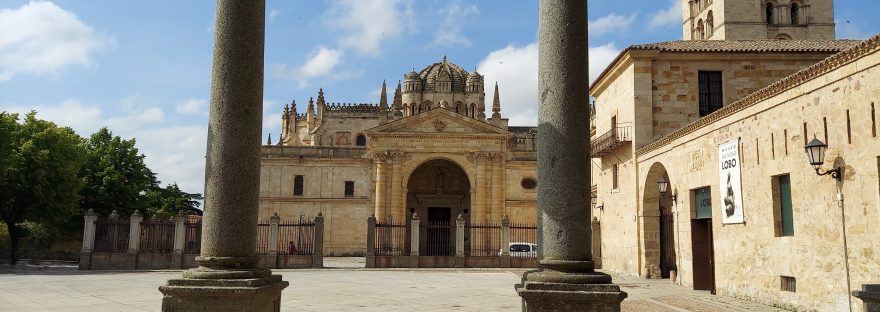The Church of Agios Nikolaos Rangavas, located in the heart of Athens’ historic Plaka neighborhood, is a hidden treasure that offers a window into the city’s rich Byzantine heritage. This elegant Orthodox church, dedicated to St. Nicholas, is renowned for its unique architectural features, historical significance and for being the oldest church in Athens. Continue reading “Saint Nicholas Church of Athens, Greece”
Category: Blog English
Cathedral Basilica of St. Dionysius the Areopagite of Athens, Greece
A hidden treasure in the vibrant city of Athens in Greece, which certainly deserves a visit is the Roman Catholic Cathedral of St. Dionysius the Areopagite. This temple is a true jewel of religious architecture that captivates with its rich history and is a palpable testimony of the cultural heritage and religious fervor that characterizes this city. Continue reading “Cathedral Basilica of St. Dionysius the Areopagite of Athens, Greece”
Roman Agora of Athens, Greece
Located between the Acropolis of Athens and Monastiraki Square is the impressive Roman Agora. This enclosure, a legacy of the Roman presence in Greece, was built between 19 B.C. and 11 B.C., under the rule of Emperor Augustus, and later expanded by the philhellenic emperor Hadrian, a great defender of this culture and its traditions. In 267, after the invasion of the Heruli (Germanic people who inhabited Northern Europe and participated in the invasion of the Roman Empire), the city of Athens was limited to the interior of the late Roman wall. The administrative and commercial center of the city was moved from the ancient Agora to the Roman Agora and Hadrian’s Library. Continue reading “Roman Agora of Athens, Greece”
The Aljafería Palace, Zaragoza, Spain
The Aljafería Palace, a majestic fortified building, was built in Zaragoza, Spain during the second half of the 11th century. Its construction was ordered by Abu Ja’far Ahmad ibn Sulaymán al-Muqtadir Billah, known by his honorific title of Al-Muqtadir, “the Powerful”, as his recreational residence. The name of Aljafería is derived from the pronoun of Al-Muqtadir, Abu Ya’far, and from “Ya’far”, “Al-Yafariyya”, which evolved into “Aliafaria” and from there to “Aljafería”. Initially, the construction was carried out outside the Roman wall, on the plain known as La Almozara, a place where Muslims carried out their military exercises. With the passing of time and urban expansion, the building has been integrated into the city. Continue reading “The Aljafería Palace, Zaragoza, Spain”
Athens, Greece: Its largest church and its smallest church
The Metropolitan Cathedral of Athens, known to Greeks as Mitropoli, is a majestic church of Byzantine origin dedicated to St. Mary of the Assumption. Located in the Plaka district, right at the foot of the Acropolis, it is currently the largest church in Athens and the seat of the Archbishop of Greece. Continue reading “Athens, Greece: Its largest church and its smallest church”
Cathedral of the Savior, Zamora, Spain
From the Cathedral Square you can see the smallest and oldest of the eleven cathedrals of the Community of Castilla y León. Dedicated to the Savior, it is located at the highest point of the city of Zamora and belongs to the so-called Romanesque of the Duero. In 1889 it was declared a National Monument. Regarding the dates of the beginning and end of the works of the cathedral, there is no agreement among historians. It is said that it was built by a single master and that it was finished in 1174, coinciding with the reign of Alfonso VII. Continue reading “Cathedral of the Savior, Zamora, Spain”
The Kapnikarea Church, one of the oldest in Athens, Greece
The Church of Panagia Kapnikarea, is considered a relic of Byzantine architecture and one of the oldest Orthodox churches in the city of Athens. According to archaeological research, this Byzantine church where the ancient Greeks worshipped the goddess Athena or Demeter, was built over an ancient temple in the 11th century, probably in the year 1050, a common practice among early Christian churches. Today, it is dedicated to the Virgin Mary, known as “Panagia”. Continue reading “The Kapnikarea Church, one of the oldest in Athens, Greece”
Cuenca, Spain: Las Casas Colgadas (The Hanging Houses)
The Hanging Houses or Casas Colgadas, are the symbol of the Spanish city of Cuenca in Castilla la Mancha and we were eager to get there and see them. They are a group of buildings that were built between the 13th and 15th centuries. The name Casas Colgadas (Hanging Houses) is due to the fact that part of them are cantilevered, with large balconies overhanging the high rocky ledge of the Huécar River gorge. Continue reading “Cuenca, Spain: Las Casas Colgadas (The Hanging Houses)”
Pantheon of the Countess of Vega del Pozo, Guadalajara, Spain
We like to recommend that when visiting a new city, always start with the place that most intrigues you or that you have always wanted to visit. In our case, when we arrived at Guadalajara Station, we headed to the Pantheon of the Countess of Vega del Pozo and Duchess of Sevillano, an impressive monument built between 1882 and 1916 in this Spanish city. This magnificent pantheon was commissioned by Doña María Diega Desmaissières y Sevillano, Countess of Vega del Pozo and Duchess of Sevillano, in honor of her father and deceased relatives, who would find their eternal resting place here. The pantheon is part of the monumental complex of the foundation of San Diego de Alcalá. Continue reading “Pantheon of the Countess of Vega del Pozo, Guadalajara, Spain”
The Oracle of Delphi, Greece
“I warn you, whoever you are, who yearn to inquire into the mysteries of nature, that, if you do not find within yourself that which you seek, neither will you find it without. If you ignore the virtues of your own abode, how can you hope to discover other excellencies? In thee resides that which is the Treasury of Treasures.” Message of the Oracle of Delphi.










